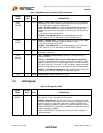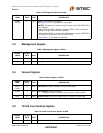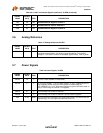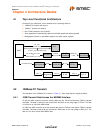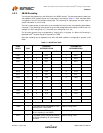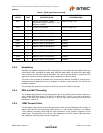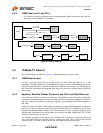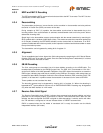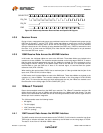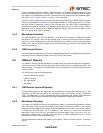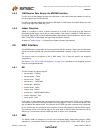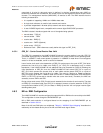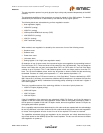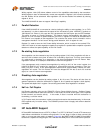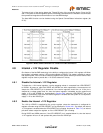
MII/RMII 10/100 Ethernet Transceiver with HP Auto-MDIX and flexPWR
®
Technology in a Small Footprint
Datasheet
Revision 1.0 (04-15-09) 24 SMSC LAN8710/LAN8710i
DATASHEET
Figure 4.3 Relationship Between Received Data and Specific MII Signals
4.3.8 Receiver Errors
During a frame, unexpected code-groups are considered receive errors. Expected code groups are the
DATA set (0 through F), and the /T/R/ (ESD) symbol pair. When a receive error occurs, the RXER
signal is asserted and arbitrary data is driven onto the RXD[3:0] lines. Should an error be detected
during the time that the /J/K/ delimiter is being decoded (bad SSD error), RXER is asserted true and
the value ‘1110’ is driven onto the RXD[3:0] lines. Note that the Valid Data signal is not yet asserted
when the bad SSD error occurs.
4.3.9 100M Receive Data Across the MII/RMII Interface
In MII mode, the 4-bit data nibbles are sent to the MII block. These data nibbles are clocked to the
controller at a rate of 25MHz. The controller samples the data on the rising edge of RXCLK. To ensure
that the setup and hold requirements are met, the nibbles are clocked out of the transceiver on the
falling edge of RXCLK. RXCLK is the 25MHz output clock for the MII bus. It is recovered from the
received data to clock the RXD bus. If there is no received signal, it is derived from the system
reference clock (XTAL1/CLKIN).
When tracking the received data, RXCLK has a maximum jitter of 0.8ns (provided that the jitter of the
input clock, XTAL1/CLKIN, is below 100ps).
In RMII mode, the 2-bit data nibbles are sent to the RMII block. These data nibbles are clocked to the
controller at a rate of 50MHz. The controller samples the data on the rising edge of XTAL1/CLKIN
(REF_CLK). To ensure that the setup and hold requirements are met, the nibbles are clocked out of
the transceiver on the falling edge of XTAL1/CLKIN (REF_CLK).
4.4 10Base-T Transmit
Data to be transmitted comes from the MAC layer controller. The 10Base-T transmitter receives 4-bit
nibbles from the MII at a rate of 2.5MHz and converts them to a 10Mbps serial data stream. The data
stream is then Manchester-encoded and sent to the analog transmitter, which drives a signal onto the
twisted pair via the external magnetics.
The 10M transmitter uses the following blocks:
MII (digital)
TX 10M (digital)
10M Transmitter (analog)
10M PLL (analog)
4.4.1 10M Transmit Data Across the MII/RMII Interface
The MAC controller drives the transmit data onto the TXD BUS. For MII, when the controller has driven
TXEN high to indicate valid data, the data is latched by the MII block on the rising edge of TXCLK.
The data is in the form of 4-bit wide 2.5MHz data.
5D5 data data data data
RXD
RX_DV
RX_CLK
5D5
data data data data
CLEAR-TEXT
5JK
5 55
TR
Idle



